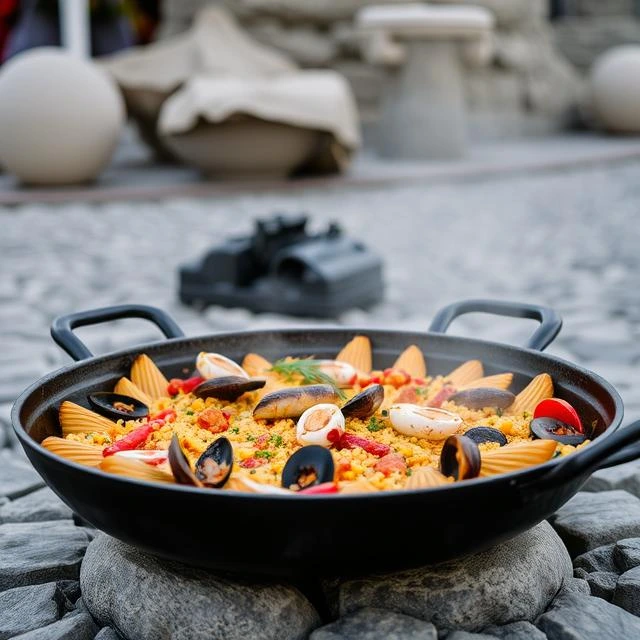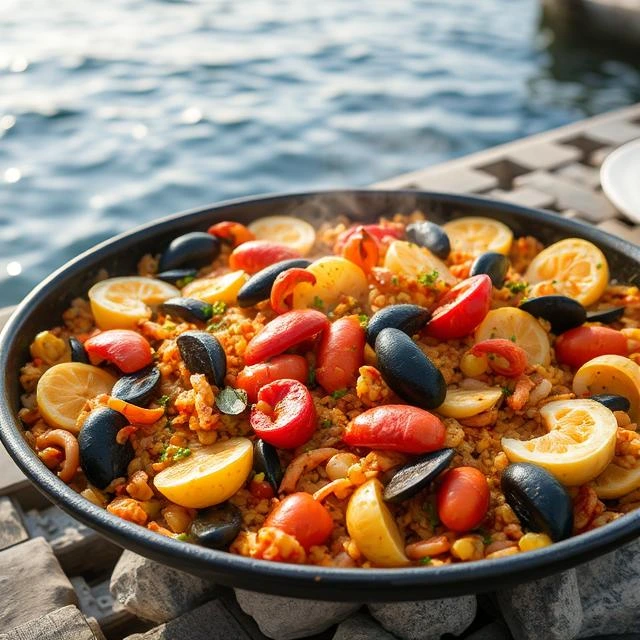INTRODUCTION
Paella, Spain’s iconic rice dish, is a culinary masterpiece that combines vibrant flavors, rich history, and communal joy. Originating in Valencia, this dish has evolved into a global symbol of Spanish cuisine, celebrated for its golden saffron-infused rice, succulent proteins, and the coveted socarrat—a caramelized crust at the bottom of the pan. In this guide, we’ll explore the secrets to crafting an authentic paella, from selecting ingredients to mastering technique, ensuring your creation rivals those served in coastal Spanish villages.
A Brief History of Paella
Paella’s roots trace back to Valencia in the 18th century, where farmers and laborers cooked rice over open fires with ingredients like rabbit, snails, and seasonal vegetables 710. The dish’s name derives from the wide, shallow paellera pan, designed to ensure even cooking. Over time, coastal regions introduced seafood, while modern adaptations now include chorizo, artichokes, and even vegetarian twists 46. Today, paella is a centerpiece of Spanish celebrations, embodying tradition and innovation.

Essential Ingredients for Authentic Paella
The magic of paella lies in its simplicity and quality. Here’s what you’ll need:
1. Rice: The Foundation
- Bomba rice is the gold standard. Its short grains absorb three times their volume in liquid without turning mushy, creating a creamy yet firm texture 614.
- Substitutes: Calasparra or Arborio rice can work in a pinch, but adjust broth quantities to avoid sogginess 47.
2. Saffron: The Golden Thread
This precious spice lends paella its signature color and earthy aroma. Use threads, not powder, and steep them in warm broth to release their essence 1014.
3. Proteins and Seafood
- Seafood: Mussels, clams, shrimp, and squid (cleaned and debearded) are classics. Freshness is non-negotiable—avoid anything with a fishy odor 613.
- Meats: Chicken thighs (juicier than breasts) or rabbit add depth. Chorizo, though non-traditional, offers a smoky kick 47.
4. Sofrito: The Flavor Base
A sautéed mix of onions, garlic, bell peppers, and tomatoes forms the aromatic foundation. Some recipes use sofrito (a slow-cooked tomato paste) for intensity 614.
5. Broth: Liquid Gold
Homemade fish or chicken stock is ideal. For seafood paella, simmer shrimp shells or fish bones for an umami-rich base 614.

Step-by-Step Guide to Perfect Paella
1. Prep Your Ingredients
- Clean seafood thoroughly. Soak mussels/clams in salted water to purge sand 1314.
- Chop vegetables uniformly for even cooking.
2. Build the Sofrito
- Heat olive oil in a paellera or wide skillet.
- Sauté onions, garlic, and bell peppers until soft 47.
- Add tomatoes and cook until caramelized, forming a jammy base 14.
3. Brown the Proteins
- Sear chicken or rabbit in the pan, then set aside. For seafood, cook briefly to avoid overcooking 613.
4. Toast the Rice
Stir rice into the sofrito, coating each grain in oil. This step enhances nuttiness and prevents clumping 14.
5. Add Broth and Saffron
- Pour in hot broth (3:1 ratio to rice) and saffron infusion.
- Key tip: Never stir after this step! Stirring releases starch, leading to mushy rice 14.
6. Layer the Ingredients
- Arrange seafood, meats, and vegetables atop the rice.
- Add peas or artichokes for color 713.
7. Achieve the Socarrat
- Cook uncovered on medium-high until liquid evaporates.
- Listen for a crackling sound—the socarrat is forming. A golden crust means success 110.
8. Rest and Serve
- Let the paella rest for 5–10 minutes. Garnish with lemon wedges and parsley 46.
Pro Tips for Paella Perfection
- Pan Choice: A traditional paellera ensures even heat distribution. No pan? Use a wide skillet or Dutch oven 413.
- Heat Control: Maintain medium heat. Too high, and the bottom burns; too low, and the rice undercooks 17.
- Broth Temperature: Use hot broth to avoid shocking the rice, which stalls cooking 14.
- Patience: Resist peeking! Trust the process for that crispy crust 10.
Common Mistakes to Avoid
- Overcrowding the Pan: Limit proteins and veggies to prevent uneven cooking 7.
- Using Long-Grain Rice: It turns mushy. Stick to Bomba or Calasparra 6.
- Stirring After Adding Broth: This disrupts the socarrat 1.
- Skipping Saffron: Turmeric is no substitute! Saffron’s flavor is irreplaceable 10.
Modern Twists on Tradition
- Vegetarian Paella: Swap meats for artichokes, mushrooms, and green beans 47.
- Black Paella: Add squid ink for dramatic color and briny flavor 6.
- Fusion Paella: Experiment with chorizo, quinoa, or even a paella mixta (mixed meats and seafood) 313.
Serving and Pairing Suggestions
- Presentation: Serve family-style in the pan for authenticity 10.
- Sides: Pair with a crisp salad, garlic aioli, or crusty bread 13.
- Wine: A dry Spanish Albariño or Verdejo complements the dish’s richness 14.
Conclusion: A Dish That Brings People Together
Paella is more than a meal—it’s a celebration of culture, patience, and shared joy. By honoring tradition while embracing creativity, you can master this Spanish classic. Whether you’re cooking for a festive gathering or a cozy night in, let the aromas of saffron and seafood transport you to Valencia’s sunlit shores.
Further Reading:
- Explore more Spanish recipes: Tortilla de Patatas 4
- Dive into Valencian culinary history: The Origins of Paella 10
- Watch a paella masterclass: Saveur’s Step-by-Step Guide 1
¡Buen provecho!